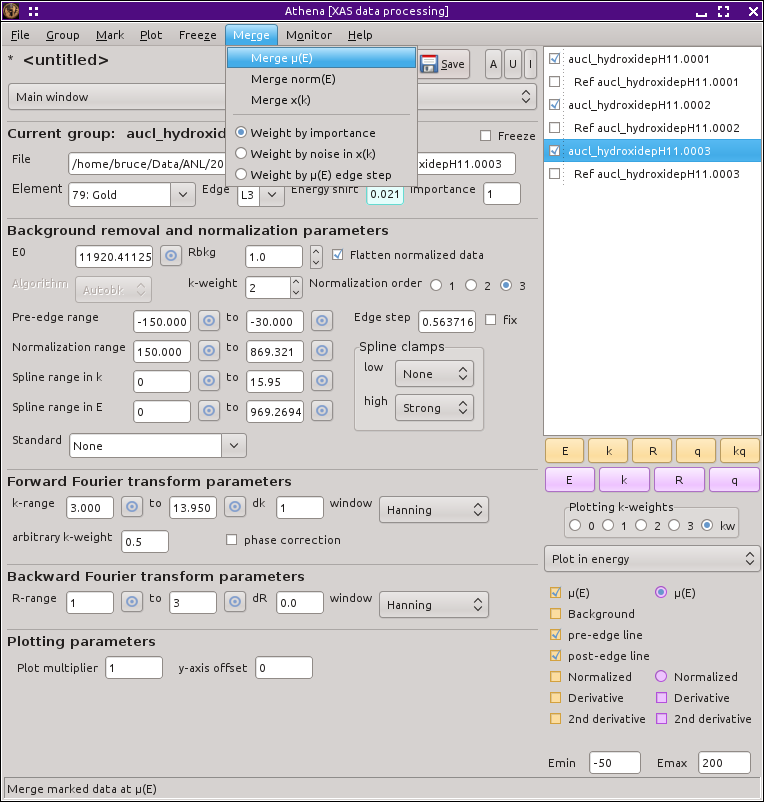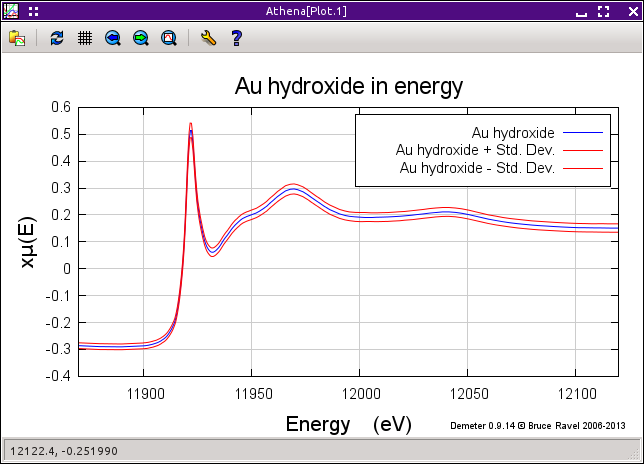Merging data groups
Averaging scans and computing their standard deviation
Sadly, most data that we measure is, frankly, kind of crappy. A
single scan typically ranges from noisy to so dominated by noise that
it's hard to recognize it as oscillatory. Fortunately,
the central limit theorem
works every single time. If you add up enough noisy
scans, it eventually turns into real data!
All entries in the group list which are marked will be included in the
merge. Make sure that the marked groups really are the ones you want
to include in the merge!
Data can be merged as μ(E), normalized μ(E), or χ(k).
In most cases, it makes little difference which one you choose.
χ(R) will be the same regardless. (This can be tested, in fact,
I encourage you to do so.) The standard deviation in the merged data
is also computed and stays with the data in project and certain output
files, although ATHENA does nothing else with the standard
deviation other than plotting it, which is shown
below.
By default, each data set is weighted the same in the merge.
After a merge is made, a plot is displayed showing the merge in some manner.
The type of merge plot is controled by the
♦Athena → merge_plot
configuration parameter.
The default is to show the data along with the data ± the
standard devaition, as shown below. The other options are the
the variance plot
or a plot with the merge and all the data that entered the merge.
The data merging feature is one of ATHENA's most important.
My typical work pattern is to carefully align the scans measured on a
sample, merge them, then further work with the merged data in
ATHENA and ARTEMIS.
 It is essential that your data be well-aligned before merging.
Merging poorly aligned data has the effect of significantly attenuating
the fine structure.
It is essential that your data be well-aligned before merging.
Merging poorly aligned data has the effect of significantly attenuating
the fine structure.
When merging as μ(E) or normalized μ(E), if every data group
included in the merge has a reference channel, the reference channels
will also be merged and these two merged spectra will be tied together
as
a reference channels.
Thus the merge of the reference channels can serve as the alignment
standard for the merge of the data.
There is one situation where merging as μ(E) will be substantively
different from the other two options. If something happens to change
the values of the signals on the detectors in such a way that μ(E)
for subsequent scans is of very different sizes but the normalized
μ(E) data is consistent for all the data, then the merge in μ(E)
will be dominated by the scans with larger absolute values while the
merge in normalized μ(E) will treat all the data with similar
weights. One way of having this happen is to change amplifier gains
between scans. In that situation, you probably should choose to merge
normalized or χ(k) data.
Merging options
-
Weighting options
-
There are three ways to weight the spectra which go into the merge.
The default is to merge by the value of the «importance» parameter.
Since the «importance» is by default 1, this choice usually means to
weight the spectra equally in the merge. Because «importance» is a
user-definable parameter, the weighting can be made in any way by
setting those values appropriately. The other two options are
attempts to weight according to quality of data. The
“noise” option uses IFEFFIT's
measure of noise in χ(k), thus giving more weight to data with
less shot noise. The “edge step” uses the
value of «edge step» determined form the
normalization, thus giving more weight to data with larger edge steps.
The idea for the edge step option is that, for data measured in
fluorescence, a more concentrated sample has a larger edge step and is
likely to give higher quality data. The choice between the
three weighting options is made using the radio buttons in the Merge menu.
-
Preferences
-
There are preferences
which have some influence on how the merge happens.
♦Merge → exclude_short_data
allows you to choose whether to exclude data sets with far fewer data
points into the merge. The default to exclude short data sets.
♦Merge → short_data_margin
defines how many fewer data points triggers that exclusion for a data set.
♦Merge → weightby sets the
default choice of weighting option between the three options explained
above.
Keyboard shortcuts
There are keyboard shortcuts for merging:
Control-shift-m : merge as μ(E)
Control-shift-n : merge as
normalized μ(E)
Control-shift-c : merge as χ(k)
![[Athena logo]](../../images/pallas_athene_thumb.jpg)


 It is essential that your data be well-aligned before merging.
Merging poorly aligned data has the effect of significantly attenuating
the fine structure.
It is essential that your data be well-aligned before merging.
Merging poorly aligned data has the effect of significantly attenuating
the fine structure.